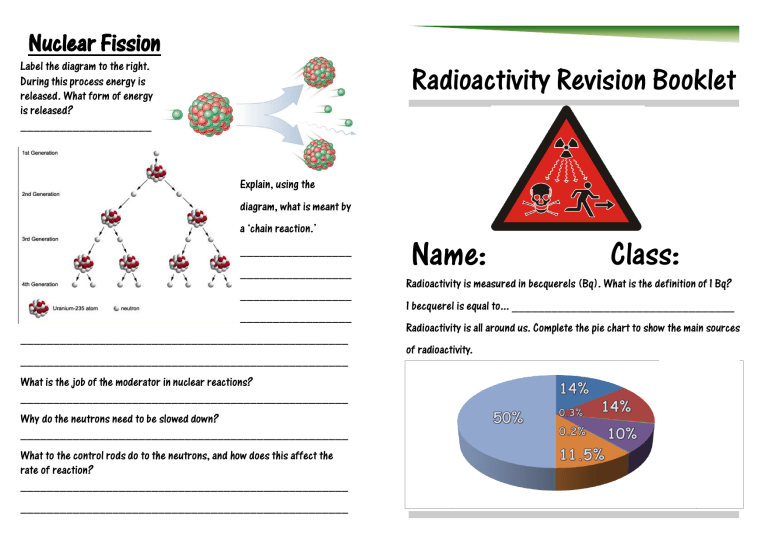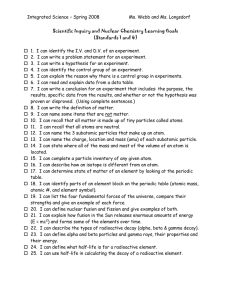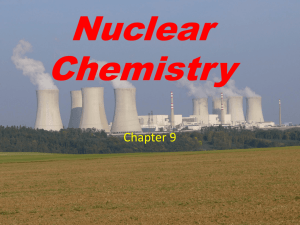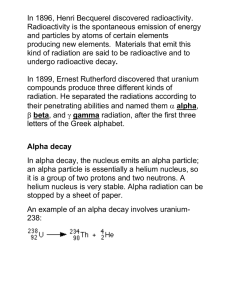
Nuclear Fission Label the diagram to the right. During this process energy is released. What form of energy is released? ____________________ Radioactivity Revision Booklet Explain, using the diagram, what is meant by a „chain reaction.‟ _________________ _________________ _________________ _________________ __________________________________________________ __________________________________________________ Name: Class: Radioactivity is measured in becquerels (Bq). What is the definition of 1 Bq? 1 becquerel is equal to... __________________________________ Radioactivity is all around us. Complete the pie chart to show the main sources of radioactivity. What is the job of the moderator in nuclear reactions? __________________________________________________ Why do the neutrons need to be slowed down? __________________________________________________ What to the control rods do to the neutrons, and how does this affect the rate of reaction? __________________________________________________ __________________________________________________ Ground & Buildings Ground & Buildings Ground & Buildings Medical Medical Medical Nuclear Power Nuclear Power Nuclear Power Cosmic Rays Cosmic Rays Cosmic Rays Other Other Other Food and Drink Food and Drink Food and Drink Radon Gas Radon Gas Radon Gas Atoms and Radioactivity Atoms are made of three different particles; protons, neutrons, and electrons. The protons and neutrons are found in the nucleus. The electrons orbit the nucleus. Label one of each of the three particles. This is an atom of lithium. Give the atomic number and mass number below. Particles Li Atomic Particle Relative Mass Electron 1 Proton Neutron Relative Charge +1 Geiger and Marsden fired alpha particles at very thin gold foil. Most of the alpha Complete the table to the left. 2000 The number of protons in an atom identifies the element. For example, carbon atoms always have six protons. The number of neutrons can vary. Atoms with the same number of protons, but different numbers of neutrons, are called isotopes. Carbon-12 Carbon-13 Carbon-14 Three different carbon isotopes 12 13 C C C are shown. Complete the chemical 6 6 symbols The nucleus of an atom is held together by the strong force. This is strong enough to overcome the electric force repelling the protons away from each other. When atoms become too large, or they contain too many or too few neutrons, they become unstable. An unstable nucleus will decay. Decay splits an atom apart, giving out energy, radiation and fragments of the original nucleus. particles passed straight through. Some of the alpha particles were deflected. Draw some deflected particles on the diagram and explain why they were deflected. ____________________________________________________ ____________________________________________________ ____________________________________________________ A small amount of particles seemed to “bounce” back. Why? ____________________________________________________ ____________________________________________________ ____________________________________________________ What conclusion about the structure of the atom was made from these results? ____________________________________________________ ____________________________________________________ ____________________________________________________ Applications of Radioactivity Fill in the gaps using the words at the bottom of the page: Ionising Radiation A neutral atom can be ionised by alpha, beta, or gamma radiation. Radioactive iodine-123 is absorbed into the thyroid gland in exactly the same way as any stable isotope. Iodine-123 is a _____ emitter. The gamma rays can be detected using a _____ ______, which is used to build up a ________ of functioning and non-functioning areas of the thyroid. Radiation can cause damage to cells and the DNA in cells. These mutations will be copied when a cell divides, and can lead to abnormal growth and cancer. Very high doses can kill cells. Chemicals can be used to ______ cancerous cells. They are attached to radioactive isotopes that emit alpha or ____ radiation. The radiation kills the cancer cells, and because they have a low degree of _________ they affect only the areas they are delivered to. This avoids killing too many _____ cells. Ionising radiation can also be used in __________. The radiation kills _____ ____, e.g. Bacteria, without harming the item. ________ tools can electron ionising radiation the ____ of liquids and gases, and in __________ dating. Words to use: gamma camera living cells gamma beta target healthy Medical thickness picture radiocarbon flow penetration sterilisation positive atom Alpha, Beta, and Gamma An alpha particle is identical to a ____ nucleus - two _____ and two ______ without an orbiting electrons. They have an atomic number of _ and a mass number of _. Alpha radiation is the most _______ and least _______ of the three. 4 He 2 Or α A beta particle is a fast-moving electron. They are smaller and carry less charge than _____ particles, so they interact less frequently with matter in their path. They are more ________ and less _______ than alpha particles. 0 -1β be sterilised in this way. Radiation can also be used to gauge the _________ of a material, tracking neutral atom Gamma rays are ___________ waves. They have no _____ or ______. They are the most penetrating and least ionising radiation. Radiation Penetrating Power Alpha Beta Gamma Ionising Power Radiation Stopped By High Medium Thin aluminium Thick lead Alpha and Beta Decay Radiation and Half-life protons and two neutrons - the atomic number decreases by 2, the mass the original ____ of the sample to decay. number decreases by 4. Different radioactive isotopes have different half-lives, e.g. uranium -238 During alpha decay a nucleus emits an alpha particle. The atom loses two 222 Ra 88 218 Rn 86 + 2 He 4 ...here is an example Th + 234 U 92 Now try this one... The half-life of a radioactive sample is the average ____ taken for ____ has a half-life of 4.5 billion years, whereas polonium-218 has a half-life of 4 He 2 only 3 minutes. Calculate the half-life from the following graph: During beta decay a neutron turns into a proton and an electron - this __________________ electron is emitted from the nucleus. The mass number remains the same, __________________ however the atomic number increases by one. __________________ 137 Cs 55 137 Ba 56 + -1e Now try this one... 0 ...here is an example 14 C 6 __________________ __________________ 0 e -1 N Half-life:____________ Radon-222 has a half life of 3.825 days. How long will it take for a 10 g When alpha or beta decay occurs there is sometimes excess energy in the sample to decay to: nucleus. This energy is emitted as gamma radiation. Gamma rays have no 5 g __________ mass or charge, so there is no change to the nucleus. A 1 g sample of radium-226 decayed to 0.25 g after 3180 years. How long Alpha and Beta Decay Rules: is the half-life for radium-226? Radiation Particle Emitted Alpha Helium Nucleus Beta Change to Atomic Number Change to Mass Number -4 +1 2.5 g__________ 1.25 g__________ _________________________________________________ _________________________________________________ What fraction of a sample is left after 5 half-lives? _________________________________________________




